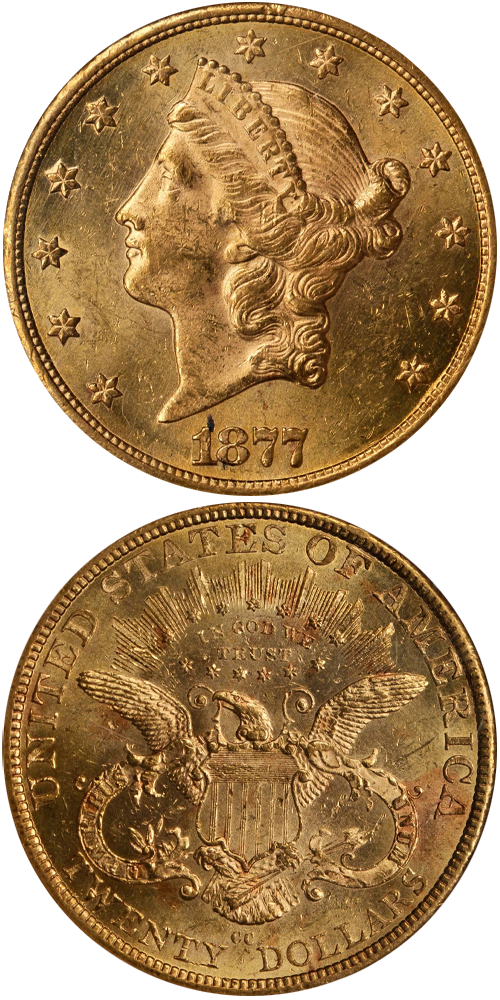1877-CC Liberty Head Double Eagle
Jeff Ambio: The only known die marriage of the 1877-CC double eagle exhibits a medium size, compact date that is set low in the field (the digits are much closer to the denticles than to the base of Liberty's portrait). The C mintmark is centered over the space between the words TWENTY and DOLLAR, with the individual Cs a bit taller than those seen on all of the preceding issues in the Carson City Mint double eagle series. The mintmark leans to the left ever so slightly.
Rusty Goe: In 1877, Linderman commissioned Chief Engraver William Barber to look for ways to improve the appearance on some U.S. coins, especially the double eagles. Barber and others submitted designs for all sorts of U.S. coins in 1877. The Mint Bureau chose Barber's modified design for the double eagle in 1877, which essentially decreased the size of Miss Liberty's head slightly, repositioned it so her coronet would point between stars 6 and 7, and on the reverse changed the denomination from TWENTY D. to TWENTY DOLLARS.
The coiners at Carson City waited anxiously for the new dies. However, a problem with the first sets of dies to arrive from Philadelphia early in 1877, prevented Coiner Dague at the Carson Mint from turning out any gold coins in the first three months.
When the Carson Mint's coining department finally resumed the production of double eagles in April 1877, it did so at a turtle's pace. The total of 13,421 for the first half of the year came in at less than one-fifth of what Dague's department had averaged in three prior six-month periods. A disappointing performance for sure, but then there was also the decline in the percentages of Comstock gold coming into the mint to factor in. By mid-1877, the Nevada branch counted it a good fortune to receive ten percent of the mines' still record-setting yields of bullion. The 29,124 pieces produced in the second half of 1877 combined with the first half's output totaled less than one-third of the previous year's high-water mintage. This figure would appear as a notable number, compared to what was to follow. One small consolation: because of the modified design, the $20 gold pieces produced starting in 1877 displayed slightly bolder details.
At least three percent of the original mintage of 1877-CC double eagles survives, which despite its relatively low output, offers more opportunities for today's collectors. Mint State examples, however, are still a challenge to locate.
Q. David Bowers: From the mintage of 1877-CC double eagles, Rusty Goe estimates 1,250 to 1,450 of which 35 to 40 are Mint State. Most of the latter are around the MS-60 level and show many bagmarks. Nearly all of these have been brought back from foreign bank holdings in recent decades. Old-time collections formed before 1950 nearly always contained circulated examples. VF and EF are typical grades for circulated pieces on the market before 1980. Since that time many imported pieces have been in the EF to AU level.
The example to the left was sold by Stack's Bowers Galleries in the August 2012 Battle Born Collection of Carson City Coinage, where it realized $64,625.






